MPC’s fifth group of prehistoric animals included one truly original mold in the form of Diatryma (ie Gastornis), one of the earliest plastic representations of this icon from the post-Mesozoic age.
During the 1950s and 1960s, interest in paleontology was starting its climb back to mainstream interest, and companies like Marx took the initiative to start producing dinosaurs and other prehistoric creatures in small plastic fashion for the first time, encouraging kids to create prehistoric worlds in their own homes. Multiple Products Corporation (MPC), evidently recognizing Marx’s success, joined the new prehistoric toys bandwagon and released a couple waves of their own figures – albeit most of which were inferior imitations of Marx’s own designs. In 1962, however, MPC’s second series of molds introduced a handful of creatures Marx had never touched. Most of these new figures were prehistoric mammals; but one new dinosaur, the giant flightless avian Diatryma, was also introduced as part of the “5th” mold group.

Diatryma gigantea (“through-a-hole giant”, for the bird’s size and the perforations in the foot bones) was first described in 1876, although it was later reclassified as a species under the genus Gastornis (Gaston’s bird), described previously in 1855. Diatryma became a staple of paleoart and Cenozoic-related pop culture, often depicted as a hulking, but fast-moving predator that terrorized early horses and other small mammals. In more recent years, studies of Diatryma (now Gastornis) which focused on its beak shape and the isotopic signatures of its bones produced results indicating the giant bird was probably a herbivore instead of a carnivore. Considering how aggressive some modern plant-eating birds like geese and swans can be, however (to say nothing of large mammalian herbivores!), I dare say a living, 2-meter-tall Gastornis would still have been a creature to tread carefully around.
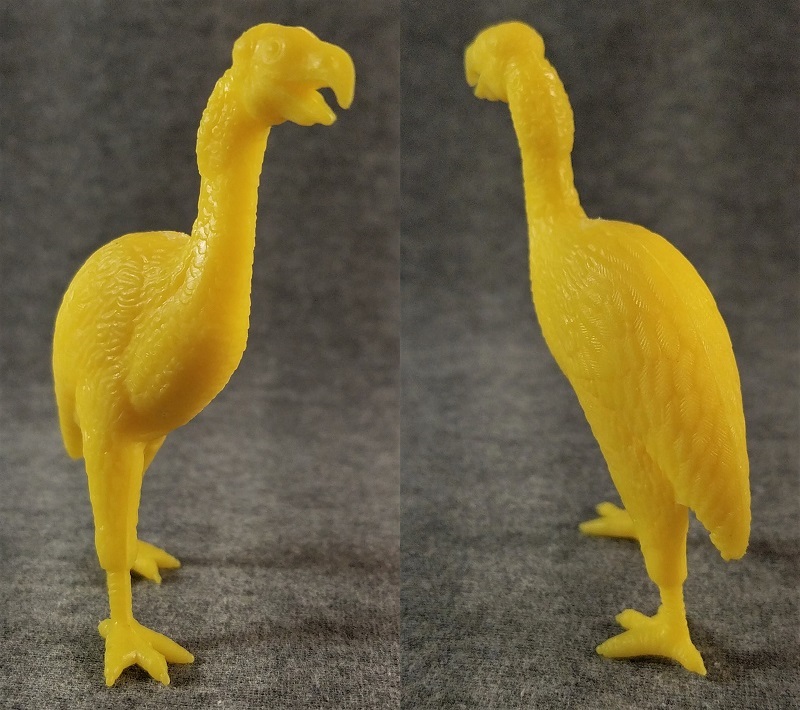
A number of toy companies have tried their hand at the “Gaston’s Bird” over the years; however to my knowledge the MPC figurine is the very first. Still labeled as Diatryma with an engraved size of 7’ long (both found on the front right of the body), the toy stands about 6.5 cm (2.5 in) tall, making it one of the tallest items from MPC’s prehistory output (obviously early toy companies weren’t concerned about strict scaling between genera). The figurine stands relatively well-balanced on its two feet, posed in a short stride with its body and neck raised high. The beak is sculpted open, perhaps in the midst of vocalization or maybe panting on a hot day. Circles from the molding process are visible on the left side of the figure.
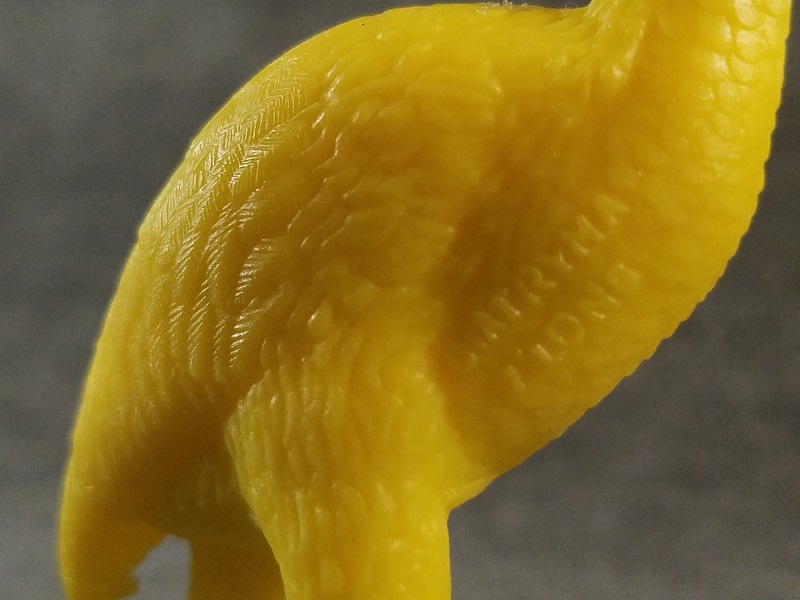
MPC originally released the “mold group 5” figurines – consisting of Diatryma, Moschops, Styracosaurus and Smilodon – in gray and silver, but would later release them in other colors of plastic as well, including yellow, brown, and blue. All of my copies of Diatryma are a bright lemon yellow. Color variety was one of the notable ways MPC differentiated their toys from their predecessor Marx, who produced their own figures in more natural, subdued tones. The Diatryma and its compatriots would see release and re-release over the decades in a number of different playsets and blister packs, up through the nineties and onward as MPC would change names and ownership, and the original molds would be sold and distributed for broader market use.
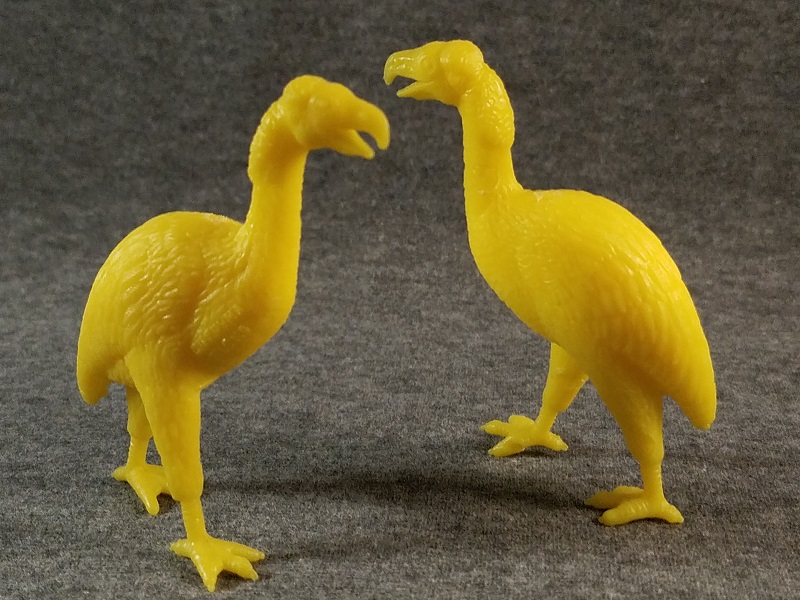
Although generally looking accurate to fossils in anatomical proportions, there are a few quirks to MPC’s Diatryma design. Many, or most, Diatryma/Gastornis toys have drawn inspiration from classic depictions like the artwork of Zdenek Burian. MPC was likely no different than its successors in this regard, but they seem to have taken some creative choices of their own as well. The legs are appropriately long, but quite rigidly straight in posture, possibly for stability’s sake. The body is somewhat narrow in lateral view, not unlike some of the other non-avian dinosaurs MPC produced; however it’s maybe a little more odd for a fully-feathered creature. This Diatryma could stand to gain some pounds, or maybe just another layer of floof; then again, more body mass would have probably done a number on the stability as a toy. Making successful toys is a give-and-take design process, as much now as it was then. Interestingly, the plumage itself seems to discard the popular ratite motif of “hairy” feathers in favor of more developed feather forms, which vary in size and shape depending on the body region.
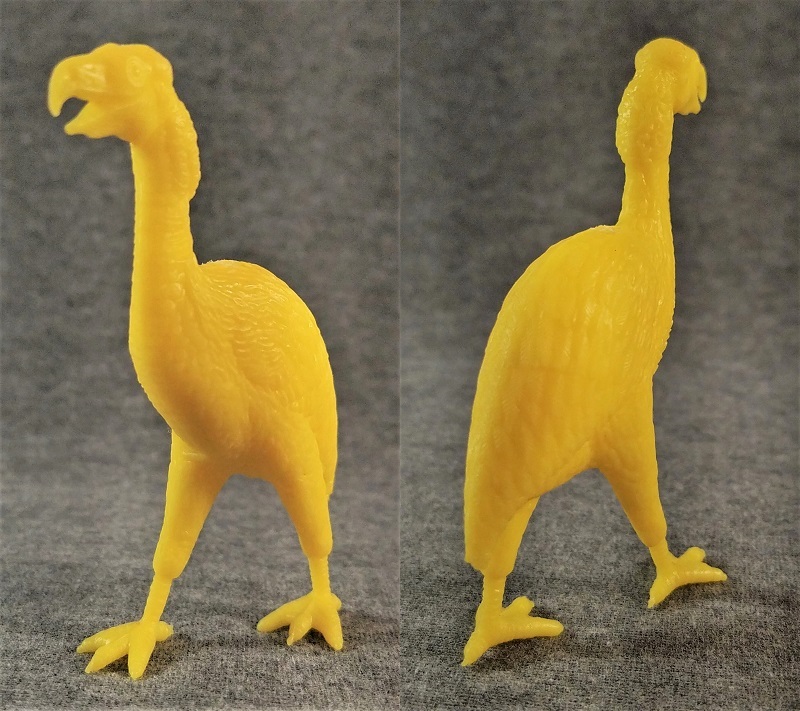
In other anatomy, the neck of the toy is proportioned well, but still appears somewhat lacking in mass, especially for needing to support such a robust skull – or so it would be, if the skull were actually robust. The figure almost completely lacks the animal’s signature bone/nut-cracking beak, deep and powerful in form, almost reminiscent of the jaws of a toothed giant theropod of old. Instead, the toy displays a more slender, hooked beak, making this giant avian look more like some carnivorous variant of moa. I suspect MPC might have been referencing materials such as this skeletal from 1881, as well as this life restoration from around 1917, judging by some similarities in beak structure; in their defense, I have no idea what sort of reference materials would have been easily available in the 1960s, be it publicly or through private museum resources. We’re so spoiled for access to information these days it’s easy to forget such wasn’t always the case!
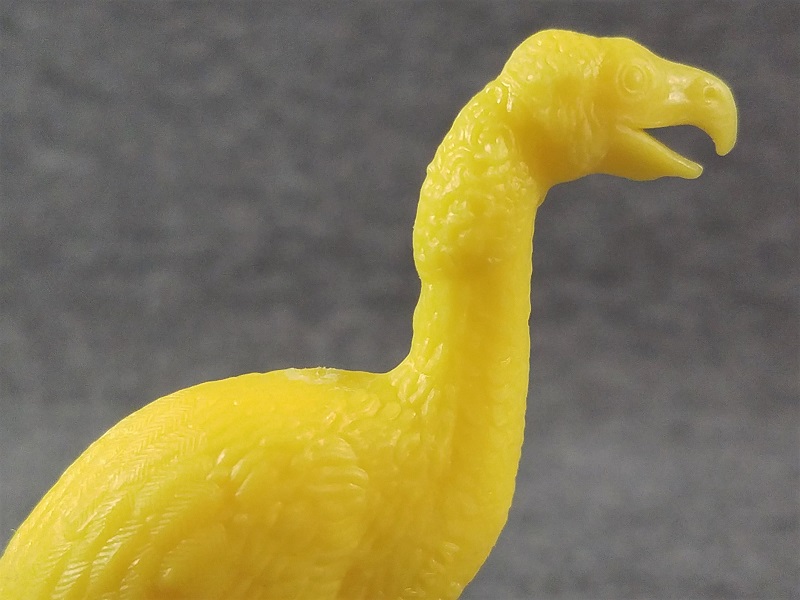
MPC delivered a pretty solid depiction of Diatryma for being the first of its kind, in a time when prehistoric animal replicas were still a new industry niche. The figurine stands as a nice representation of vintage paleoart with a little unique flavor of its own. Although MPC doesn’t really exist as a company anymore, enough production runs and re-runs over the decades have guaranteed this toy still remains relatively easy to find on the second-hand market, in one form or another. Identifying originals can be tricky, but they will typically be more detailed and be made with sturdier plastic. Happy hunting!
Disclaimer: links to Ebay and Amazon on the DinoToyBlog are affiliate links, so we make a small commission if you use them. Thanks for supporting us!




Nice review Fembrogon, MPC were good when they came up with original designs, would have been nice to see more of them.
I used to love these as a kid. I still have about 20 of these Marx prehistoric animals, along with a few cavemen and ferns, in a sealed plastic bag though I can’t imagine I’d ever display them again.